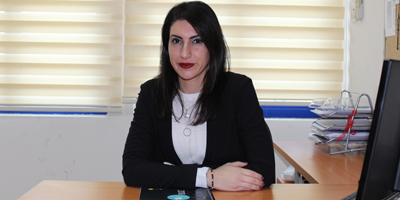EUL Academician Alptuğ discussed “The Role of Physical Activity in Preventing Breast Cancer”

European University of Lefke (EUL) Health Sciences Faculty Physiotherapy and Rehabilitation Department Lecturer Specialist Physiotherapist Beraat Alptuğ gave information on “The Role of Physical Activity in Preventing Breast Cancer” within the scope of breast cancer awareness month.
Expressing that one out of every eight women and one in every thousand men are affected by breast cancer, Alptuğ said, “The survival rate for breast cancer, which is the most frequently diagnosed cancer among women, has increased by about 20 percent since the 1970s and is now about 90 percent. Thanks to advances in early detection and treatment of breast cancer, the survival rate is increasing. Treatment for breast cancer is a difficult process. Treatment options include surgery (biopsy, lumpectomy, mastectomy, reconstruction), radiation and/or chemotherapy. Although these treatments increase survival, they can cause severe side effects, both physically and psychologically. The most common side effects in the treatment of breast cancer are scar tissue, pain in the shoulder, chest, back, neck or arm, limitation of movement in the shoulder and neck region, lymphedema, weakness and fatigue, neuropathy (nerve damage), gastrointestinal system disorders, axillary web syndrome. It can be sorted as a type of treatment and can be diversified according to the treatments applied.
Specialist Physiotherapist Alptuğ talked about the role of physical activity in preventing breast cancer and gave important messages for awareness:
How can physiotherapy help?
Physiotherapy is involved in every stage of breast cancer treatment. Most importantly, the role of physiotherapy is important in the prevention of breast cancer with patient education and regular physical activity programs. Women who exercise regularly (physical activity) have a lower risk of breast cancer than women who are not active. According to studies, women who exercise regularly have a 10-20 percent lower risk of breast cancer than women who are not active. This effect is more pronounced in postmenopausal women. Physical activity is still important after breast cancer treatment.
How much physical activity do you need?
The American Cancer Society recommends doing 150-300 minutes (2½-5 hours) of moderate physical activity (or 75-100 minutes (about 1-2 hours) of vigorous activity) per week. This amount of activity is associated with a reduced risk of cancer in general.
Moderate activities include walking, gardening and slow dancing. Intense activities include jogging, playing tennis and swimming. You don’t need to do intense exercise to reduce your risk of breast cancer. Women who have the same activity as walking for 30 minutes a day have a nearly 3 percent lower risk of breast cancer than women who are inactive.
Why is exercise associated with breast cancer risk?
Exercise may be linked to a lower risk of breast cancer for several reasons. First of all, it can help with weight control. Thin women have a lower risk of breast cancer after menopause compared to overweight women. Also, being active can lower blood estrogen levels. Women with low blood estrogen levels have a lower risk of breast cancer than women with high levels. Finally, exercise can strengthen the body’s immune system, thereby helping to kill cancer cells or slow their growth.
Tips for increasing physical activity
Being active is good for your health, but finding time to exercise can be difficult, but small changes you make in your life can have a big impact. E.g;
• Do any activity you enjoy that gets you moving (for example, dancing or gardening).
• Take the stairs instead of the elevator.
• Walk or bike instead of driving.
• Take your pet for a walk.
• Exercise at lunch or take an exercise break to stretch or take a brisk walk.
• Plan active holidays.
• Leverage technology to track your steps.
• Use a stationary bike or treadmill while watching TV.
AWARENESS MESSAGES ON BREAST CANCER
1. Know your risk
• Talk to both sides of your family to learn about your family’s health history.
• Talk to a healthcare professional about your breast cancer risk
2. Scan
• If you are at higher risk, contact a healthcare professional about which screening tests are right for you.
• Have a mammogram every year from age 40 if you are at average risk
• Have a clinical breast examination at least every 3 years from the age of 20 and every year from the age of 40.
3. Find out what is normal for you and see a healthcare professional if you notice any of these breast changes:
• Lump, hard knot or thickening in the breast or armpit area
• Swelling, warmth, redness or darkening of the breast
• Change in the size or shape of the breast
• Pitting or shrinking of the skin
• Itchy, scaly sore or rash on the nipple
• Retraction of the nipple or other parts of the breast
• Sudden onset nipple discharge
• New pain that does not go away at one point
4. Make healthy lifestyle choices
• Maintain a healthy weight
• Add exercise to your routine
• Limit alcohol intake
• Limit menopausal hormone therapy (postmenopausal hormone use)
• Breastfeed if possible
At the end of her words, Alptuğ concluded by saying, “A healthy lifestyle has benefits at all ages, it is never too late to diagnose and adopt it.”
